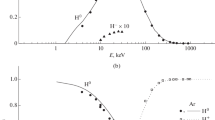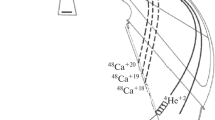Summary
Measurements were made of relative stopping powers of several materials in the proton energy intervals (750÷600) MeV, (600÷450) MeV, (450÷300) MeV and (750÷0) MeV. By collimation and magnetic analysis a «pencil beam» free of degraded particles was extracted from the 184 in. cyclotron. Using this beam in «good geometry» the stopping powers of Al, Pb, U and emulsion were measured relative to Cu. The total ranges yield the most accurate estimates of the mean excitation potentials. It is assumed that the mean excitation potential of Al is 163 eV, and that at 750 MeV substantially all the tight binding corrections required are those for theK andL shells. The mean excitation potentials in eV found with these assumptions are: copper, 323; lead, 826; uranium, 917; and emulsion, 328. The results from the differential stopping-power measurements are in general accord with these data. However, the agreement of the differential measurements with the theoretical ratios could be improved by raising the above mean excitation potentials of Al and Pb or by lowering those of copper, uranium and emulsion. This experiment confirms the general shape of theI/Z vs Z curve found by Bakker and Segrè, and when similarly normalized, is in reasonable absolute agreement. The status of the emulsion range-energy table is reviewed in the light of these and other relevant measurements. Incidental observations were made on the scattering, straggling and attenuation behavior of a highly collimated monoenergetic beam of protons which was brought to rest in a large block of copper.
Riassunto
Abbiamo eseguito la misura del potere relativo d’arresto di alcuni materiali entro gli intervalli di energia dei protoni (750÷600) MeV, (600÷450) MeV, (450÷300) MeV e (750÷0) MeV. Mediante collimazione ed analisi magnetica, abbiamo estratto dal ciclotrone di 184 in. un «pennello» privo di particelle degradate. Usando questo fascio in «buona geometria», abbiamo misurato il potere d’arresto dell’Al, del Pb, dell’U e dell’emulsione, relativamente al Cu. I percorsi totali forniscono le stime più accurate dei potenziali medi di eccitazione. Si suppone che il potenziale medio di eccitazione dell’Al sia 163 eV, e che a 750 MeV tutte le richieste correzioni di legame stretto siano sostanzialmente quelle per gli stratiK edL. I potenziali medi di eccitazione in eV, trovati in base a queste supposizioni, sono: rame, 323; piombo, 826; uranio, 917; emulsione, 328. I risultati, dedotti dalle misure del potere d’arresto differenziale, sono generalmente in accordo con questi dati. Comunque l’accordo fra le misure differenziali ed i rapporti teorici può essere migliorato elevando i suddetti potenziali medi di eccitazione dell’Al e del Pb od abbassando quelli del rame, dell’uranio e dell’emulsione. Questo esperimento conferma la forma complessiva della curvaI/Z in funzione diZ trovata da Bakker e Segrè, che, analogamente normalizzata, concorda in modo ragionevolmente assoluto. Alla luce di queste e di altre importanti misure abbiamo riveduto la composizione della tabella percorso-energia, Incidentalmente abbiamo eseguito delle osservazioni su comportamento di scattering, straggling ed attenuazione di un fascio monoenergetico di protoni, fortemente collimato, che venne fatto arrestare in un grosso blocco di rame.
Similar content being viewed by others
Literatur
J. Lindhard andM. Scharff:Kgl. Danske Videbskab. Selskab, Mat.-fys. Medd.,27, No. 15 (1953).
W. Brandt:Energy Loss and Range of Charged Particles in Compounds, du Pont Radiation Physics Laboratory Report (July, 1960).
C. J. Bakker andE. Segrè:Phys. Rev.,81, 489 (1951).
R. Mather andE. Segrè:Phys. Rev.,84, 191 (1951).
For exampleH. Bichsel, R. F. Mozley andW. A. Aron:Phys. Rev.,105, 1788 (1957).
W. H. Barkas:Nuovo Cimento,8, 201 (1958).
W. H. Barkas, P. H. Barrett, P. Cüer, H. Heckman, F. M. Smith andH. K. Ticho:Nuovo Cimento,8, 91 (1958).
S. von Friesen andW. H. Barkas: Lawrence Radiation Laboratory Report, UCID-613 (Jan. 1959).
H. Bichsel andE. Uehling:Phys. Rev.,119, 1670 (1960).
B. Rossi:High-Energy Particles (New York, 1952).
R. Sternheimer:Phys. Rev.,117, 1621 (1690).
H. Bichsel: Private correspondence. We are much obliged toDr. Bichsel for being permitted to use his tables before their publication.
M. C. Walske:Phys. Rev.,101, 940 (1956).
D. C. Sachs andJ. R. Richardson:Phys. Rev.,89, 1163 (1953).
K. R. MacKenzie:Penetration of Charged Particles in Matter, Report no. 29, Nuclear Science Series, National Research Councils Publication 729.
H. Bichsel:Phys. Rev.,112, 1089 (1958). AlsoH. Bichsel in ref. (5).R. F. Mozley andW. A. Aron:Phys. Rev. 105, 1788 (1957).
S. von Friesen andW. H. Barkas:Bull. Am. Phys. Soc.,4, 369 (1959).
O. Heinz:Phys. Rev.,94, 1728 (1954).
H. G. de Carvalho andJ. I. Friedman:Rev. Sci. Inst.,26, 261 (1955).
D. M. Ritson, A. Pevsner, C. S. Fung, M. Widgoff, G. T. Zorn, S. Goldhaber andG. Goldhaber:Phys. Rev.,101, 1085 (1956).
R. W. Birge, D. H. Perkins, J. R. Peterson, D. H. Stork andM. N. Whitehead:Nuovo Cimento,4, 834 (1956).
G. Stack Collaboration:Nuovo Cimento Suppl.,4, 398 (1956).
J. Crussard, V. Fouché, G. Kayas, L. Leprince Ringuet, D. Morellet, F. Renard andJ. Trembley:Nuovo Cimento Suppl.,3, 373, 616 (1956).
W. H. Barkas andA. H. Rosenfeld:UCRL-8030, Revised (Sept., 1960).
R. Feldman: Lawrence Radiation Laboratory Report,UCRL-3802 (1957).
M. W. Friedlander, D. Keefer andM. G. K. Menon:Nuovo Cimento,5, 461 (1957).
J. N. Dyer, W. H. Barkas, H. H. Heckman, C. J. Mason, N. A. Nichols andF. M. Smith:Bull. Amer. Phys. Soc.,5, 224 (1960). For more details seeJ. D. Dyer:UCRL-9450.
V. P. Zrelov andG. D. Stoletov:Sov. Phys. JETP,36 (9), 461 (1959).
R. Sternheimer:Phys. Rev.,58, 854 (1952).
Author information
Authors and Affiliations
Additional information
Traduzione a cura della Redazione.
Rights and permissions
About this article
Cite this article
Barkas, W.H., von Friesen, S. High-velocity range and energy-loss measurements in Al, Cu, Pb, U and emulsion. Nuovo Cim 19 (Suppl 1), 41–62 (1961). https://doi.org/10.1007/BF02819680
Received:
Published:
Issue Date:
DOI: https://doi.org/10.1007/BF02819680




